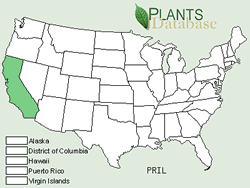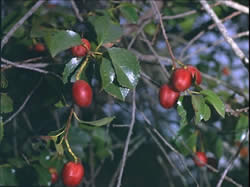Plant of the Week
 Range map of Islay. States are colored green where the species may be found.
Range map of Islay. States are colored green where the species may be found.
 Islay (Prunus ilicifolia) flowers. Photo by Br. Alfred Brousseau.
Islay (Prunus ilicifolia) flowers. Photo by Br. Alfred Brousseau.
 Islay (Prunus ilicifolia) fruit. Photo by William R. Hewlett, California Academy of Sciences.
Islay (Prunus ilicifolia) fruit. Photo by William R. Hewlett, California Academy of Sciences.
Islay (Prunus ilicifolia (Nutt. ex Hook. & Arn.) D. Dietr.)
By Forest Jay Gauna
Islay is the Spanish term for this plant; the USDA PLANTS Database common name is "hollyleaf cherry," which is a translation of the Latin binomial. Islay is a Hispanic translation of the native Californian word for this species. This plant was an important one to the local native people of southern and central California.
Prunus is a genus of paramount importance to humans. It is Latin for a plum tree, but other species of the genus give us cherries, apricots, peaches, and almonds, as well as native fruits such as Klamath plum, chokecherry, crabapple, and bitter cherry. Trees and shrubs of this genus are very popular in landscaping. This especially true in the nation’s capital where hundreds of Japanese flowering cherries bloom every spring when a Cherry Blossom Festival is held to the delight of locals and tourists alike. Members of this genus provide us with food items such as apples, cherries, plums, and peaches as well as ornamental flowering trees and shrubs.
Islay is used for both ornamental and food. It is often planted as an ornamental as its leaves are shiny, deep green that last through winter, and its fringed flowers make for inspiring white inflorescences. It has the common name of hollyleaf cherry because its leaves are evergreen and shiny, as well as serrated, thus resembling those of holly (Ilex spp.). The fruits are reddish to purplish, and from a half to an inch long. They are relished by wildlife that are dependent upon soft mast especially migrating birds.
Where found in the wild, they are plants of the chaparral: associates include scrub oak, buckeye, and California bay tree. Bees pollinate the flowers.
Islay has been used as a food in a variety of ways, and has been an important food item for Native Americans. The flesh may be eaten, and is described as tart. However, it is the pit of the fruit that had important value for native Californians: it was ground and specially prepared to remove the cyanide-producing compounds, and then used as a” meal.” The sap is also used as a sweetener similar to maple syrup (Acer saccharum).

